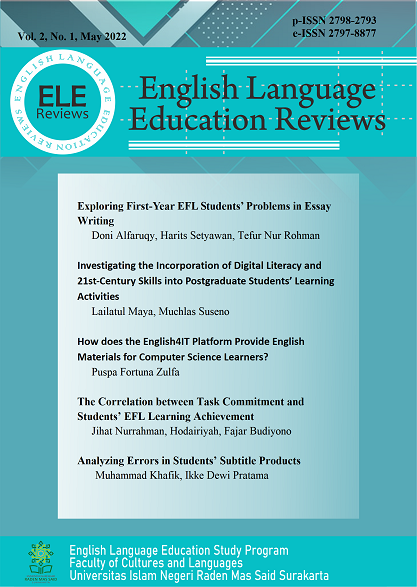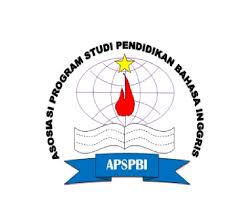Analyzing Errors in Students’ Subtitle Products
DOI:
https://doi.org/10.22515/elereviews.v2i1.5180Keywords:
audiovisual translation, meaning, subtitling, subtitling constraints, subtitling errorsAbstract
Subtitling has constraints that are different from other types of translation. In the pedagogical field, lecturers in subtitling courses must ensure that the students are aware of the constraints to creating a qualified subtitle. The constraints in subtitling frequently cause errors in the subtitles composed by the students. This article discusses the errors found in students’ subtitle products. The researchers took the subtitles of Miacademy Youtube channel videos composed by EFL students studying in one of the state universities in Central Java, Indonesia. Nine videos of Miacademy and their subtitles were analyzed to find the errors in the subtitles. The results revealed that the most frequent error is errors in spatial parameters, specifically on the excessive number of characters per line. The second most dominant error is the errors in the temporal parameter in which most of the students still found problems in obeying the rules of the maximum duration for either a full two-line or a single-line subtitle. Punctuation and letter case errors result from students’ lack of comprehension in mastering the target text language convention. Error in target text editing mainly occurs due to the too-long subtitles, segmentation that is not syntactically acceptable, the decision to omit or retain the source text, and the occurrence of dialect. Further analysis showed that the students need to practice adjusting their translation with the constraints. Likewise, a subtitling brief must be conducted before the lecturer delivers the task to the students by helping the students analyze the possible problems and solutions when composing the subtitles.
Downloads
References
Alabsi, T. (2020). Effects of adding subtitles to video via apps on developing EFL students’ listening comprehension. Theory and Practice in Language Studies, 10(10), 1191-1199. https://doi.org/10.17507/tpls.1010.02
Anwar, F. Z. (2020). Strategies and techniques of translation in translating songs as 21st century curriculum. Manajemen Pendidikan, 15(1), 34-43. https://doi.org/10.23917/mp.v15i1.10744
Bogucki, L. (2004). The constraint of relevance in subtitling. JoSTrans: The Journal of Specialised Translation, 1, 71-88. http://citeseerx.ist.psu.edu/viewdoc/summary?doi=10.1.1.233.1380
Cintas, D., & Anderman, G. (2009). Introduction. In G. A. J. Díaz Cintas (Ed.), Audiovisual Translation: Language Transfer on Screen (pp. 1-17). Palgrave Macmillan.
Cintas, D., & Remael, A. (2007). Audio-visual Translation: Subtitling. St. Jerome Publishing.
Dhari, P. W. P., & Suarnajaya, I. W. (2017). An analysis of subtitling strategy in the La La Land movie (2016). Jurnal Pendidikan Bahasa Inggris Undiksha, 4(2). https://ejournal.undiksha.ac.id/index.php/JPBI/article/view/15053
Gottlieb, H. (1992). Subtitling: A new university discipline. In C. Dollerup & A. Loddegaard (Eds.), Teaching Translation and Interpreting. John Benjamins Publishing Company.
Halim, H. A. (2019). Translation errors in Malaysian children’s movie subtitles. The CALA 2019, The Conference on Asian Linguistic Anthropology, 467-472.
Hatim, B., & Mason, I. (2000). Politeness in screen translation. In L. Venuti (Ed.), The Translation Studies Reader. Routledge.
Izzah, N., & Diana, L. (2021). Beyond the implementation of project-based assessment in ELT: Benefits, challenges, and teachers’ strategies. Celtic: A Journal of Culture, English Language Teaching, Literature and Linguistics, 8(2), 140-151. https://doi.org/10.22219/celtic.v8i2.18208
Jahanshahi, M., & Kafipour, R. (2015). Error analysis of English translation of Islamic texts by Iranian translators. Journal of Applied Linguistics and Language Research, 2(3), 238-252.
Janecová, E. (2012). Teaching audiovisual translation: Theory and practice in the twenty-first century. Çankaya University Journal of Humanities and Social Sciences, 1(May), 17-29.
Karamitroglou, F. (1998). A proposed set of subtitling standards in Europe. Translation Journal, 2(2).
Kasriyati, D., Rafiah, S., Herdi, & Abbas, M. F. F. (2019). Lexical errors found in subtitling projects of EFL learners of University of Lancang Kuning. Lectura: Jurnal Pendidikan, 10(2), 155-166.
Khalaf, A. S., Rashid, S. M., Jumingan, M. F., & Othman, M. S. (2014). Problems in amateur subtitling of English movies into Arabic. Malaysian Journal of Languages and Linguistics (MJLL), 3(1), 38-55. https://doi.org/10.24200/mjll.vol3iss1pp38-55
Koolstra, C. M., Peeters, A. L., & Spinhof, H. (2002). The pros and cons of dubbing and subtitling. European Journal of Communication, 17(3), 325-354. https://doi.org/10.1177/0267323102017003694
Liu, D. (2014). On the classification of subtitling. Journal of Language Teaching and Research, 5(5), 1103-1109. https://doi.org/10.4304/jltr.5.5.1103-1109
Matamala, A., Perego, E., & Bottiroli, S. (2017). Dubbing versus subtitling yet again? Babel. Revue Internationale de La Traduction / International Journal of Translation, 63(3), 423-441. https://doi.org/10.1075/babel.63.3.07mat
Murtiningsih. (2013). Kesalahan berbahasa Indonesia mahasiswa S-1 PGSD STIKIP Nuuwar Fak-Fak. Jurnal Penelitian Ilmu Pendidikan, 6(1), 74-82.
Neves, J. (2004). Language awareness through training in subtitling. In P. Orero (Ed.), Topics in Audiovisual Translation (pp. 127-140). John Benjamins Publishing Company.
Nida, E., & Taber, C. (1974). The theory and practice of translating. Brill.
Pahamzah, J., & Syariifah, A. (2019). Translation techniques of subtitling: A case for Trolls movie. Journal of English Language Teaching and Cultural Studies, 2(2), 86-95. https://doi.org/10.48181/jelts.v2i2.9097
Pedersen, J. (2017). The FAR model: Assessing quality in interlingual subtitling. Journal of Specialised Translation, 28, 210-229.
Pratama, I. D. (2017). Meaning and form in nursery rhymes translation. Humanus: Jurnal Ilmiah Ilmu-Ilmu Humaniora, 16(1), 1-12. https://doi.org/10.24036/jh.v16i1.665
Pratama, I. D., Retnaningsih, W., & Prakoso, M. R. (2021). Interlingual subtitles to increase high school students’ ability in understanding explanation texts. Metathesis: Journal of English Language, Literature, and Teaching, 5(1), 19. https://doi.org/10.31002/metathesis.v5i1.2701
Sajna, M. (2013). Amateur subtitling-selected problems and solutions. In M.
Sajna, V. Bilić, A. Holderbaum, A. Kimmes, J. Kornelius, J. Stewart, & C. Stoll (Eds.), T21N-Translation in Transition. Wissenschaftlicher Verlag Trier.
Spradley, J. P. (2007). Metode etnografi. Tiara Wacana.
Suryawan, G. A. N. D., & Winaya, I. M. (2018). Translation strategies of idioms: With special reference to “Anak Semua Bangsa” and “Child of All Nations.” Humanis, 22(1964), 823. https://doi.org/10.24843/jh.2018.v22.i03.p38
Wicaksono, D. B., & Wahyuni, E. (2018). An analysis of the strategies used in translating idioms in Indonesia into English found in Indonesian legends. Celtic: A Journal of Culture, English Language Teaching, Literature and Linguistics, 3(1), 45. https://doi.org/10.22219/celticumm.vol3.no1.45-55
Wongranu, P. (2017). Errors in translation made by English major students: A study on types and causes. Kasetsart Journal of Social Sciences, 38(2), 117-122. https://doi.org/10.1016/j.kjss.2016.11.003
Downloads
Published
How to Cite
Issue
Section
Citation Check
License
Copyright (c) 2022 Muhammad Khafik, Ikke Dewi Pratama

This work is licensed under a Creative Commons Attribution-NonCommercial 4.0 International License.
Authors retain copyright and grant the journal right of first publication with the work simultaneously licensed under a Creative Commons Attribution License that allows others to share the work with an acknowledgement of the work's authorship and initial publication in this journal.
This ejournal system and its contents are licensed under
a Creative Commons Attribution-NonCommercial 4.0 International License








